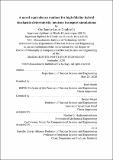| dc.contributor.author | Giudicelli, Guillaume Louis. | en_US |
| dc.contributor.other | Massachusetts Institute of Technology. Department of Nuclear Science and Engineering. | en_US |
| dc.date.accessioned | 2022-10-12T14:59:16Z | |
| dc.date.available | 2022-10-12T14:59:16Z | |
| dc.date.copyright | 2020 | en_US |
| dc.date.issued | 2020 | en_US |
| dc.identifier.uri | https://hdl.handle.net/1721.1/145790 | |
| dc.description | Thesis: Ph. D. in Computational Nuclear Science and Engineering, Massachusetts Institute of Technology, Department of Nuclear Science and Engineering, September, 2020 | en_US |
| dc.description | Cataloged from student-submitted PDF version of thesis. | en_US |
| dc.description | Includes bibliographical references. | en_US |
| dc.description.abstract | With ever increasing available computing resources, the traditional nuclear reactor physics computation schemes, that trade off between spatial, angular and energy resolution to achieve low cost highly-tuned simulations, are being challenged. While existing schemes can reach few-percent accuracy for the current fleet of light water reactors, thanks to a plethora of astute engineering approximations, they cannot provide sufficient accuracy for evolutionary reactor designs with highly heterogeneous geometries. The decades-long process to develop and qualify these simulation tools is also not in phase with the fast-paced development of innovative new reactor designs seeking to address the climate crisis. Enabled by those computing resources, high fidelity Monte Carlo methods can easily tackle challenging geometries, but they lack the computational and algorithmic efficiency of deterministic methods. However, they are increasingly being used for group cross section generation. Downstream highly parallelized 3D deterministic transport can then use those cross sections to compute accurate solutions at the full core scale. This hybrid computation scheme makes the most of both worlds to achieve fast and accurate reactor physics simulations. Among the few remaining approximations are neglecting the angular dependence of group cross sections, which lead to an over-estimation of resonant absorption rates, especially for the lower resonances of ²³⁸U. This thesis presents a novel equivalence method based on introducing discontinuities in the track angular fluxes, with a polar dependence of discontinuity factors to preserve the polar dependence of the neutron currents as well as removing the self-shielding error. This new method is systematically benchmarked against the state-of-the-art method, SuPerHomogenization in three different approaches to obtaining equivalence factors: a same-scale iterative approach, a multiscale approach, and a single-step non-iterative approach. Both methods show remarkable agreement with a reference Monte Carlo solution on a wide array of test cases, from 2D pin cells to 3D full core calculations, for the iterative and the multi-scale approaches. The self-shielding error is eliminated, improving significantly the predictive capabilities of the scheme for the distribution of ²³⁸U absorption in the core. A single-step non-iterative approach to obtaining equivalence factors is also pursued, and was shown to only be adequate with the novel discontinuity factor-based method. This study is largely enabled by a significant optimization effort of the 3D deterministic neutron transport solver. By leveraging low level parallelism through vectorization of the multi-group neutron transport equation, by increasing the memory locality of the method of characteristics implementation and with a novel inter-domain communication algorithm enabling a near halving of memory requirements, the 3D full core case can now be tackled with only 50 nodes on an industrial sized computing cluster rather than the many thousands of nodes on a TOP20 supercomputer used previously. This thesis presents fully resolved solutions to the steady-state multi-group neutron transport equation for full-core 3D light water reactors, and these solutions are comparable to gold-standard continuous-energy Monte Carlo solutions. | en_US |
| dc.description.statementofresponsibility | by Guillaume Louis Giudicelli. | en_US |
| dc.format.extent | 542 pages | en_US |
| dc.language.iso | eng | en_US |
| dc.publisher | Massachusetts Institute of Technology | en_US |
| dc.rights | MIT theses may be protected by copyright. Please reuse MIT thesis content according to the MIT Libraries Permissions Policy, which is available through the URL provided. | en_US |
| dc.rights.uri | http://dspace.mit.edu/handle/1721.1/7582 | en_US |
| dc.subject | Nuclear Science and Engineering. | en_US |
| dc.title | A novel equivalence method for high fidelity hybrid stochastic-deterministic neutron transport simulations | en_US |
| dc.type | Thesis | en_US |
| dc.description.degree | Ph. D. in Computational Nuclear Science and Engineering | en_US |
| dc.contributor.department | Massachusetts Institute of Technology. Department of Nuclear Science and Engineering | en_US |
| dc.identifier.oclc | 1241696376 | en_US |
| dc.description.collection | Ph. D. in Computational Nuclear Science and Engineering Massachusetts Institute of Technology, Department of Nuclear Science and Engineering | en_US |
| dspace.imported | 2022-10-12T14:59:16Z | en_US |
| mit.thesis.degree | Doctoral | en_US |
| mit.thesis.department | NucEng | en_US |
